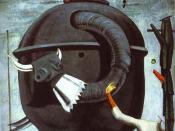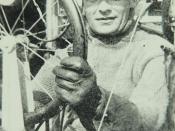Andre Masson
Andre Masson (1896-1987) was one of the major early French Surrealist painters. A close friend of Andre Breton, Joan Miro and Max Ernst, he joined the Surrealist movement in the early 20s, then disassociated with it in the early 30s, focusing instead on the human condition - the fundamental impulses of love and hatred - and reacting to the Spanish Civil War. In the early 40s, Masson moved to America and became interested in mythical imagery. Many of his paintings from this period show a focus on African American and Native American myths, and the style of his expression and brushwork influenced many young American painters.
The Painting: "Satan"
Extremely intricate and full of detail, this work evokes a sense of energy and movement. As one of the foremost Surrealist artist's, Masson encouraged his viewer to interpret his work not merely on a literal level but rather on both a conscious and subconscious level.
The painting confronts the viewer with a figure lying in the foreground, the head of the person appears shifted from the rest of body.
With realistic elements in improbable places, Masson uses the Surrealist notion of taking reality and turning it upside down. Executed with a sense of frenzied energy, this work is designed with a large number of activity and variety of colored elements in yellows, reds and greens with a range of black lines. Surrounded in the front by pleasant flowers and nature, the more threatening is revealed behind the figure with volcanic activity and smoke billowing up into the sky. It gives the viewer a sense of calmness and confusion, this work expresses the artist's intention of confronting the universal lot of man.
Set in an archival and museum quality frame with ornate gold leaf and chromium green colors. The sculptural...


